99+ Passive Sentence Examples
Dive into the realm of passive sentences, an essential tool in the writer’s arsenal. This comprehensive guide demystifies passive constructions, offering insightful examples and invaluable writing tips. Whether you’re an amateur writer or a seasoned pro, understanding and crafting passive sentences can elevate your content, adding depth and variation to your narratives.
What is the Passive Sentence? – Definition
A passive sentence is a grammatical construction where the object of an action becomes the subject of the sentence. In other words, the action’s receiver is emphasized rather than the doer of the action.
What is the best Example of a Passive Sentence?
Consider the active sentence: “The cat (subject) chased (verb) the mouse (object).” In its passive form, this sentence becomes: “The mouse (subject) was chased (verb) by the cat (agent).” Here, emphasis shifts to the mouse, the action’s receiver, rather than the cat, the action’s doer. This passive construction allows for a different narrative focus and can be particularly useful in various writing contexts.
100 Passive Sentence Examples

Description: The passive voice is an essential tool in the writer’s toolkit, emphasizing the action over the doer. Crafting passive sentences brings a distinct flavor to prose, often adding a touch of formality or objectivity. Dive into our curated list of passive sentence examples to enrich your understanding and add versatility to your writing repertoire.
- The document was signed by the CEO.
- A cure for the disease has been discovered by scientists.
- The cake was eaten by the children.
- The city was destroyed by the hurricane.
- The novel was written by an anonymous author.
- The trophy was won by the underdog team.
- The laws were enacted by the previous government.
- The mural was painted over several weeks.
- The music was composed by a renowned musician.
- The speech was delivered with great passion.
- The gift was received with much gratitude.
- The exam was passed by the majority of students.
- The forest was consumed by the wildfire.
- The film was directed by an indie filmmaker.
- The machine was operated by skilled technicians.
- The meal was prepared by a celebrity chef.
- The article was published in a prestigious journal.
- The house was built in the early 1900s.
- The course was completed by twenty participants.
- The jewels were stolen during the heist.
- The lecture was attended by students from various disciplines.
- The message was conveyed subtly in the play.
- The flowers were watered by the gardener early in the morning.
- The song was sung beautifully by the choir.
- The assignment was submitted just before the deadline.
- The announcement was made during the annual meeting.
- The puzzle was solved in record time.
- The decision was taken after much deliberation.
- The dress was worn by the actress during the film premiere.
- The report was finalized by the committee.
- The antique vase was broken during the move.
- The strategy was devised by a group of experts.
- The game was played in the pouring rain.
- The experiment was conducted under strict conditions.
- The scene was shot in a remote location.
- The idea was conceived during a brainstorming session.
- The building was renovated to its former glory.
- The poem was recited in front of a captivated audience.
- The initiative was launched to support local artisans.
- The artifacts were exhibited in the city’s main museum.
- The product was recalled due to safety concerns.
- The book was translated into multiple languages.
- The agreement was sealed after days of negotiations.
- The software was updated to the latest version.
- The garden was maintained by a team of dedicated workers.
- The art was inspired by nature’s beauty.
- The workshop was organized to enhance skills.
- The news was broadcasted across all major channels.
- The vehicle was inspected before the long journey.
- The show was hosted by a famous celebrity.
- The protocol was established for emergency situations.
- The brand was endorsed by prominent athletes.
- The theme was chosen to reflect cultural heritage.
- The story was narrated with compelling enthusiasm.
- The data was analyzed using state-of-the-art software.
- The venue was decorated in a festive theme.
- The package was delivered right on time.
- The award was received with great honor.
- The software was designed to be user-friendly.
- The rules were formulated to ensure fairness.
- The sculpture was admired for its intricate details.
- The tradition was passed down through generations.
- The samples were tested in a certified lab.
- The festival was celebrated with immense joy and fervor.
- The formula was patented after years of research.
- The village was protected by a stone wall.
- The diary was filled with personal memories and experiences.
- The documentary was produced to shed light on environmental issues.
- The innovation was recognized at an international conference.
- The letter was sealed and delivered by hand.
- The instrument was played with unmatched skill.
- The dishes were washed and put away neatly.
- The manuscript was submitted to the leading publisher.
- The process was streamlined for efficiency.
- The ingredients were sourced from organic farms.
- The talk was delivered to an eager audience.
- The efforts were appreciated by the entire team.
- The funds were raised for the charitable cause.
- The mysteries were unraveled after thorough investigation.
- The fortress was besieged for months.
- The feedback was incorporated into the final design.
- The animals were rescued from the flooded area.
- The challenge was accepted with great enthusiasm.
- The fabrics were dyed using natural colors.
- The session was moderated by an industry expert.
- The island was inhabited by a small community.
- The goals were achieved ahead of schedule.
- The monument was illuminated during the festival.
- The candidates were shortlisted based on their qualifications.
- The technology was adopted to improve production efficiency.
- The magazine was circulated among the elite of the city.
- The plan was devised with careful consideration.
- The conclusions were drawn after extensive research.
- The forest was preserved for its biodiversity.
- The password was reset for security reasons.
- The agreement was finalized after multiple meetings.
- The tree was planted in memory of a beloved one.
- The cake was topped with fresh strawberries.
- The materials were recycled to promote sustainability.
- The rumors were quashed by an official statement.
Crafting sentences in the passive voice adds a layer of depth and intrigue to the narrative. It emphasizes outcomes over actions and helps in focusing on the most crucial parts of the information being conveyed. As these examples demonstrate, the passive voice is versatile and can be used in various contexts to create engaging and meaningful content.
How do you write a Passive Sentence? – Step by Step Guide
Writing a passive sentence can be straightforward once you understand the structure. The passive voice emphasizes the action or the receiver of the action, rather than the doer. Here’s a step-by-step guide to crafting passive sentences:
- Identify the Action and Actors: Begin by identifying the main action (verb) and the two main actors: the doer (agent) and the receiver (subject).
- Active: The cat (doer) chased (action) the mouse (receiver).
- Shift the Focus to the Receiver: In a passive sentence, the focus shifts to the receiver of the action. The receiver becomes the new subject.
- Passive: The mouse (new subject)…
- Use the Correct Form of “Be”: Add the appropriate form of the verb “to be” (is, am, are, was, were) to the sentence based on the tense.
- Present Tense Passive: The mouse is…
- Use the Past Participle Form of the Main Verb: The action (verb) in the passive voice will always be in its past participle form.
- Passive: The mouse is chased…
- Optionally, Mention the Doer: If necessary, you can add the doer at the end using “by.”
- Passive: The mouse is chased by the cat.
Your passive sentence is complete!
Tips for Using Passive Sentences
- Use Sparingly: While the passive voice is valuable, it shouldn’t dominate your writing. Balance it with active sentences to keep your prose dynamic.
- Clear Communication: Ensure that even in the passive voice, the meaning of your sentence remains clear. Avoid overly complex passive constructions.
- Avoid Ambiguity: If the doer of the action is essential for clarity, don’t omit it. Example: “A mistake was made.” (By whom?)
- Great for Objectivity: Passive sentences can be useful when writing scientific reports, research papers, or any content where the focus is on the action or result, not the doer.
- Use in Varied Contexts: Passive voice isn’t restricted to any specific type of content. It’s suitable for fiction, non-fiction, business reports, journalism, and more.
- Enhance Flow: If a paragraph or section focuses on a particular object or individual, using the passive voice can maintain that focus and improve the flow of your writing.
- Be Mindful of Tense: The passive voice can be used in different tenses. Ensure you maintain consistency in your writing.
Understanding when and how to use the passive voice effectively can greatly enhance the depth and nuance of your content. Keep practicing, and over time, incorporating passive sentences will become second nature.



